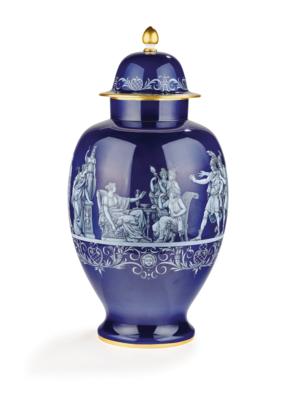A Large Lidded Vase with Limoges Paintwork and Classical Frieze, Meissen, Second Half of the 20th Century,
A Large Lidded Vase with Limoges Paintwork and Classical Frieze, Meissen, Second Half of the 20th Century,
body of bulbous form and cover with pointed knob, the side with all around antique decoration probably depicting the theme of the death of Lucretia, porcelain with cobalt blue ground and delicate pastose Limoges on-glaze painting, height without cover 51 cm, height with cover 65.5 cm, underglaze blue crossed swords mark, year letter indistinctly visible under the glaze, (GO)
In the mid-19th century, in response to the renewed interest of historicism in past style periods such as the Renaissance, new decorations and vessel forms were also developed at the Meissen Manufactory. These porcelains with Limoges painting refer to the city of Limoges in France, which was known for its richly decorated enamelware since the Middle Ages. In the 16th century in particular, a centre developed here for paintings "en grisaille", i.e. finely painted figures in shades of white or grey against a dark background with mostly classical pictorial themes.
This French Renaissance decoration, known for its perfect execution and richness of detail, was taken up by Ernst August Leuteritz, who is considered the most productive designer of the Meissen Porcelain Manufactory of the 19th century. From 1849, he was head of the design department in Meissen and primarily designed porcelain in the style of Classicism, Neo-Gothic and Neo-Renaissance.
He developed and established Limoges painting as a new, "modern" enrichment of the repertoire of the Meissen Manufactory, which was significantly influenced by Baroque and Rococo. These porcelains are characterised by clear neo-classical vessel forms and finely executed grisaille painting on a cobalt blue ground with ancient scenes.
The depiction of this large-format lidded vase appears to be a scene from the tales of early Rome. The picture frieze is divided into two main scenes. In one of the main scenes, four young women can be seen reacting negatively to armed warriors approaching. On the opposite side, citizens in Roman costume, a warrior and a woman mourn a dead man lying on a kline. Behind it is a stele with a relief of a she-wolf suckling a boy (Romulus and Remus). Thus, the pictorial theme of this large lidded vase is clearly located in Rome and suggests the interpretation of the entire frieze as a representation of the story about Lucretia and the prince Sextus Tarquinius from the early days of Rome.
23.10.2023 - 14:00
- Dosažená cena: **
-
EUR 65.000,-
- Odhadní cena:
-
EUR 50.000,- do EUR 60.000,-
A Large Lidded Vase with Limoges Paintwork and Classical Frieze, Meissen, Second Half of the 20th Century,
body of bulbous form and cover with pointed knob, the side with all around antique decoration probably depicting the theme of the death of Lucretia, porcelain with cobalt blue ground and delicate pastose Limoges on-glaze painting, height without cover 51 cm, height with cover 65.5 cm, underglaze blue crossed swords mark, year letter indistinctly visible under the glaze, (GO)
In the mid-19th century, in response to the renewed interest of historicism in past style periods such as the Renaissance, new decorations and vessel forms were also developed at the Meissen Manufactory. These porcelains with Limoges painting refer to the city of Limoges in France, which was known for its richly decorated enamelware since the Middle Ages. In the 16th century in particular, a centre developed here for paintings "en grisaille", i.e. finely painted figures in shades of white or grey against a dark background with mostly classical pictorial themes.
This French Renaissance decoration, known for its perfect execution and richness of detail, was taken up by Ernst August Leuteritz, who is considered the most productive designer of the Meissen Porcelain Manufactory of the 19th century. From 1849, he was head of the design department in Meissen and primarily designed porcelain in the style of Classicism, Neo-Gothic and Neo-Renaissance.
He developed and established Limoges painting as a new, "modern" enrichment of the repertoire of the Meissen Manufactory, which was significantly influenced by Baroque and Rococo. These porcelains are characterised by clear neo-classical vessel forms and finely executed grisaille painting on a cobalt blue ground with ancient scenes.
The depiction of this large-format lidded vase appears to be a scene from the tales of early Rome. The picture frieze is divided into two main scenes. In one of the main scenes, four young women can be seen reacting negatively to armed warriors approaching. On the opposite side, citizens in Roman costume, a warrior and a woman mourn a dead man lying on a kline. Behind it is a stele with a relief of a she-wolf suckling a boy (Romulus and Remus). Thus, the pictorial theme of this large lidded vase is clearly located in Rome and suggests the interpretation of the entire frieze as a representation of the story about Lucretia and the prince Sextus Tarquinius from the early days of Rome.
|
Horká linka kupujících
Po-Pá: 9.00 - 18.00
kundendienst@dorotheum.at +43 1 515 60 200 |
| Aukce: | Nábytek, starožitnosti, sklo a porcelán |
| Typ aukce: | Sálová aukce s Live bidding |
| Datum: | 23.10.2023 - 14:00 |
| Místo konání aukce: | Wien | Palais Dorotheum |
| Prohlídka: | 14.10. - 23.10.2023 |
** Kupní cena vč. poplatku kupujícího a DPH
Není již možné podávat příkazy ke koupi přes internet. Aukce se právě připravuje resp. byla již uskutečněna.

